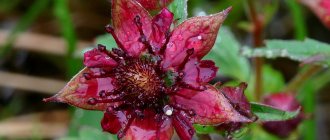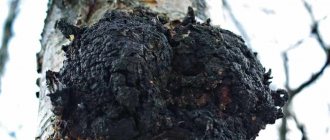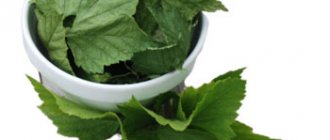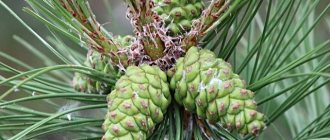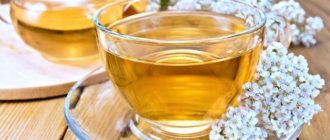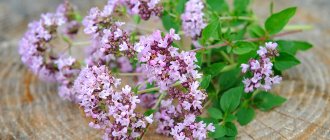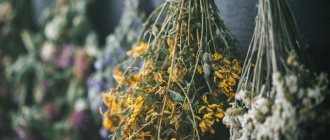Medicinal properties of thyme
The beneficial properties of thyme are due to its rich biochemical composition, which combines B vitamins, ascorbic acid, tannins, ursolic and oleic acids.
Composition of thyme:
| Nutritional and energy value | Minerals | Vitamins | |||||
| Squirrels | 9.1 g | Iron | 17.5 mg | A | 238 mcg | ||
| Fats | 7.4 g | Zinc | 1.8 mg | B1 | 0.05 mg | ||
| Carbohydrates | 63.9 g | Manganese | 1.7 mg | B2 | 0.47 mg | ||
| Water | 65 g | Magnesium | 160 mg | B5 | 0.41 mg | ||
| Alimentary fiber | 14 g | Phosphorus | 106 mg | B6 | 0.35 mg | ||
| Calorie content | 276 kcal | Copper | 0.56 mg | B9 | 45 mcg | ||
| Sodium | 9 mg | C | 160 mg | ||||
| Calcium | 405 mg | PP | 1.82 mg | ||||
| Potassium | 609 mg | Beta carotene | 2851 mg | ||||
Properties of thyme:
- It has a bronchodilator effect and facilitates expectoration during prolonged coughing.
- Used in the complex treatment of bronchitis.
- Used for dental diseases - stomatitis, gingivitis, inflammation in the oral cavity.
- It has an antiseptic and anti-inflammatory effect for tonsillitis, pharyngitis and other diseases of the upper respiratory tract.
- Lotions and compresses with thyme help with purulent wounds, ulcers, boils, and acne.
- Tea with thyme improves appetite, stimulates metabolism and accelerates the elimination of waste and toxins.
- Normalizes the functioning of the prostate gland, increases potency.
- Eliminates attacks of headaches and migraines.
The medicinal herb can be used in the complex treatment of neuritis, sciatica, radiculitis, gastritis, eliminates painful abdominal cramps, fights bloating and stool disorders.
Thyme is used as a medicinal product in the form of decoctions, infusions, and teas.
Thyme products taken internally have a positive effect on the functioning of the nervous system - they soothe, improve sleep, and reduce the negative effects of stress. The aromatic plant effectively fights depression, increased nervousness and anxiety.
Beneficial properties of thyme-based tea
Having figured out how to dry thyme, you can begin preparing a healing drink. Teas made from this herb have been known since ancient times as an effective remedy for the treatment of colds.
Active elements in the structure of the plant help eliminate insomnia and feelings of chronic fatigue. For this reason, such teas are recommended for people with weakened bodies.
Tea with thyme is an excellent means for thermoregulation. On hot days, its use will have a refreshing effect. In cold weather, the drink will fill the body with warmth. At the same time, not only adults, but also children are allowed to drink tea.
A decoction of medicinal herbs is good for dysbiosis. When used regularly, the product inhibits pathogenic microflora of the gastrointestinal tract. Substances in the plant stimulate internal secretion.
Many herbalists note that thyme tea helps expel helminths from the body. It is given to children to prevent ascariasis and destroy pinworms. For infants, a decoction of this herb will help get rid of the formation of copious amounts of gas.
Description of the plant
Thyme is a perennial plant that is found almost everywhere - in central Russia, Crimea, the Caucasus, Ukraine, and Belarus.
What does thyme look like:
- climbing subshrub up to 35-45 cm high;
- branched stems;
- woody and strong trunk;
- The leaves are small, arranged in pairs opposite each other.
During flowering, the subshrub is covered with purple, pink or lilac inflorescences that look like spherical “umbrellas”
When to collect
To harvest medicinal herbs, only the above-ground parts of the subshrub are used - foliage, stems, flowers. Thyme roots are not harvested. The plant can be found on forest edges, clearings, and mountain slopes. In many park areas the bush is grown as an ornamental perennial plant.
When to harvest thyme depends on the climatic conditions of a particular region. In the Rostov region, thyme can be harvested in the second half of June and early July, Crimean herbs bloom from June to early September, so in Crimea the medicinal plant can be harvested almost all summer. In central Russia, the flowering of thyme lasts from early June to August-September - it is during these months that it is best to harvest thyme.
Thyme for tea is collected before active flowering - from early May to June. In ancient times, healers believed that this plant should be prepared for Trinity or the Dormition of the Blessed Virgin Mary. There is a belief that on these church holidays, fragrant thyme contains the maximum amount of useful, biologically active substances.
Folk recipes
The following drinks can be prepared using thyme:
- A few tablespoons of dried crushed raw materials are poured into a glass of boiling water. A spoonful of green tea is added here. The decoction is infused for 15 minutes. This decoction eliminates coughing attacks, softens breathing, and has an anti-inflammatory effect.
- A tablespoon of thyme and a similar amount of mint are poured with boiled water. The composition is boiled over low heat for 5 minutes. The product is infused until it cools, and then filtered through a fine sieve. When consumed regularly instead of regular tea, it helps reduce the risk of developing respiratory diseases.
- Thyme, chamomile, rosemary and sweet clover are mixed in equal proportions. The composition is brewed and infused until cooled. Drink this tea several times a day, which improves the condition of the skin.
- Several inflorescences of the plant are combined with a tablespoon of any tea. The raw materials are brewed in a teapot and infused for 15-20 minutes. Use the product before bedtime. This tea helps improve sleep and reduce general irritability. The positive effect appears approximately on the third day.
Thyme, also known as thyme, is a perennial shrub that is quite common in wooded areas. Another name for this plant is thyme. The leaves and flowers are widely used both in folk medicine and for culinary purposes. Dried raw materials can be bought at the pharmacy at any time of the year, but supplies made with your own hands at home will be much more beneficial. The main thing is to follow some rules for its preparation when drying thyme.
Many people grow thyme on their own in their garden, but finding it in the wild is also not difficult. Thickets of bushes can be found on slopes and forest edges, in steppe meadows and on rocks. Thyme generally prefers dry, rocky or sandy soils.
The collection of this plant begins from May to August. In this case, only the upper above-ground part of the plant is suitable. Using a knife or sharp scissors, thin young branches with small leaves and flowers are cut, leaving only thick shoots at some distance from the ground. To preserve thickets of bushes for the next years, you need to take care of the roots of the plant and not cut out all the green mass from one bush.
For culinary purposes, thyme is harvested before it blooms, in May - June. Plants that have not yet given color contain the largest amount of aromatic oils, which has a positive effect on the taste of the product.
Medicinal infusions are prepared during the period of mass flowering of the bush. Since ancient times, it was believed that thyme had some magical properties, so it was collected on the days of such church holidays as Trinity and the Dormition of the Virgin. It was believed that it was on these days that thyme acquired unique healing properties.
Harvesting thyme should be done in dry, sunny weather. The best time for this is from 9 a.m. to 5 p.m., since by this time the plants have already completely dried out from the dew. Moisture can ruin not only the color of dried flower stalks, but also significantly increase the drying time.
Watch the video from the channel “Ekomesto” - Harvesting thyme or thyme and its beneficial properties
Collection rules
Thyme grows almost everywhere - in forests, fields, and garden plots. In order to obtain high-quality raw materials, grass is best collected in environmentally friendly places, away from industrial enterprises and highways.
On a note! Thyme can be grown at your own dacha, making it a beautiful and useful garden decoration.
Thyme for drying should be collected in warm, dry weather, best after 9 am. At this time, the leaves will have completely dried out from the dew, which will not only spoil the collected grass, but also significantly prolong the drying of the raw materials.
Collection process:
- The foliage and stems of thyme must be cut with a sharp knife blade or scissors.
- When collecting thyme, you should not try to tear off the leaves or stems of the herb - the risk of damaging the fragile root is too high, which will lead to the death of the plant.
- It is best to cut leaves and other parts of the plant from different sides of the bush.
- No more than 5 stems should be cut from one stem - this will ensure active growth and flowering of the plant next year.
- Thyme cannot be broken out by hand or pulled out along with the roots.
It is necessary to harvest leaves, stems and flowers only from healthy plants that have no traces of rot, mold, or insect damage
How is thyme stored?
It is important to know not only how to dry thyme, but also in what conditions it must be stored. The best option for storing raw materials is glass containers. You can also use canvas or cotton bags. Cardboard boxes are also suitable for these purposes. It is necessary to place the plant in such containers in a dry, well-ventilated place.
It is not recommended to distribute dried raw materials in plastic bags. Here the healing herbs will melt. This, in turn, will lead to a rapid loss of its original qualities. Following the above tips will allow you to store and use thyme for several years.
Drying
Drying thyme for the winter requires careful preparation of the collected raw materials. There is no need to wash it. It is enough just to carefully examine the branches and leaves and remove all damaged elements. If the stems are very dirty, you can quickly dip them in cold water and immediately shake off the remaining water.
You can dry thyme in the fresh air, in a microwave or oven. The first option is considered the most effective, since drying under natural conditions allows you to preserve all the beneficial substances contained in the plant. But drying it in the microwave or oven will save a lot of time.
How to dry thyme:
How to make dried bananas
- Trays or baking sheets are used to dry the herbs. Line them with clean sheets of paper.
- Spread the collected raw materials on baking sheets in a thin, even layer and place them in a shaded place; they should not be in direct sunlight.
- The tray with the plant should not be placed in a closed room, as it will quickly begin to rot.
- Drying duration is 4-6 days. It depends on the temperature and humidity. During this, you need to periodically stir and turn over the spread stems and leaves.
- Separate leaves and flowers from stems that are not needed and pour the raw materials into a bag made of natural material.
To dry thyme, you can use a special electric dryer. The way to use it is very simple - spread the grass in an even layer on trays, put it in the dryer and set the temperature to 40°. During the drying process, the trays should be periodically swapped.
Air drying involves hanging the grass in small bunches or laying it on a horizontal surface.
Recipes
There are many varieties of thyme tea. Some believe that it is necessary to use only one herb, without any additives or impurities. Others that can be combined with other components.
Most popular recipes:
- 1. Classic decoction recipe. It is recommended to use it for fatigue, insomnia, diseases of the digestive system, as well as for dry cough. This home remedy is a good prevention of flu and colds. Taking the decoction daily will strengthen the immune system and replenish the lack of vitamins and minerals. To prepare the drink, you need to pour 2 teaspoons of dried thyme into a cup of boiling water. In 20 minutes the infusion will be ready. All that remains is to strain it through a strainer. It is recommended to drink a third of a cup three times a day. Every day it is necessary to prepare a fresh product.
- 2. Blended cough tea. An herb like thyme has a mild expectorant effect. You can make tea from a special breast collection. It is necessary to take oregano, thyme, anise, primrose and plantain in equal parts. Mix everything thoroughly, and then pour 2 teaspoons of this mixture into a glass of boiling water. After 15 minutes, the drink will be ready and can be consumed after straining.
- 3. Vitamin drink. Such a remedy is required for the human body, which is completely depleted. You need to mix 1 tbsp. l. lingonberry leaves, rose hips and add the same amount of thyme. Pour 2 cups of boiling water over everything. The product will infuse in a thermos for several hours. It should be consumed half a glass 3 times a day 20 minutes before meals. It is recommended to preheat the drink.
- 4. Calming collection. This home remedy helps people when they are anxious or suffer from insomnia. The drink is useful for overwork. You need to mix 1 part each of valerian and thyme roots, and then add 2 parts peppermint. Then 1 tbsp. l. of the collection should be poured with a cup of boiling water and wait 20 minutes. It is recommended to divide the resulting solution into 3 parts and drink them throughout the day.
- 5. Gastric collection. This remedy eliminates spasms, pain, and inflammatory processes. Because of this, it can be used for flatulence, heartburn, and colic. It also improves appetite and normalizes intestinal microflora. It is necessary to mix equal parts of mint, thyme, savory and centaury. Then 2 tbsp. Pour a cup of boiling water over a l of this collection and drink after 30 minutes. It is better to divide the entire drink into 3 parts and take it gradually throughout the day.
- 6. Black tea. You can also add thyme to it. In this case, the dosage of such a plant will be minimal, but the drink will have a pleasant smell and a tonic effect. It is enough just to take an additional pinch of thyme for a regular serving of black tea, and then prepare it as usual. At the end you can add milk, honey, ginger, cinnamon, lemon. Thanks to such components, tea will become even healthier.
- 7. Green tea. You can also add thyme to it while preparing the drink. This product improves digestion and helps with weight loss. It also eliminates coughs, spasms, facilitates breathing, and fights inflammatory processes. This drink has a tonic effect in addition to everything else. It is necessary to brew green tea in the usual way, but add a pinch of thyme. In 5 minutes the drink will be ready. You can add honey and lemon to it.
It is difficult to overdose on thyme tea. But it is better to first consult a doctor before drinking the drink. This is especially true for people with various chronic diseases, as well as women during pregnancy and breastfeeding. This is due to the fact that the herb contains an essential oil such as thymol. It is extremely useful, but in overdose it becomes toxic.
What are the features of storing plants? How to dry thyme for tea? You can learn about all this from our material.
Proper storage
Thyme can be stored in various containers - glass jars, fabric bags, cardboard boxes or paper bags. Raw materials should be poured into containers only after they are completely dry - even a few wet leaves can cause mold and ruin the entire workpiece.
Dried thyme must be stored at a temperature no higher than +20°, in a darkened and well-ventilated area. If moisture appears in a bag, bag or box with a plant, it can be poured onto paper or a baking sheet and dried again.
On a note! When stored in glass jars, temperatures up to +30° are allowed. Under such conditions, the shelf life of thyme is 24 months.
Thyme is one of the most common medicinal plants. Tea and decoction with its addition have a beneficial effect on the body, improves general condition and is used in the complex treatment of many diseases.
Timely collection and proper drying of thyme helps to prepare useful raw materials for medicinal and culinary purposes throughout the year.
How to store dry thyme
Before storing, leaves for tea are freed from hard stems and sifted. Then the workpiece is transferred into glass or ceramic containers in a layer of no more than 7 centimeters. You can also store thyme in canvas bags.
The shelf life of the dried product is 1 year. After the specified time, thyme reserves should be renewed.
Thyme or thyme is widely used in folk medicine. Collecting thyme for drying for the winter is a great idea, because the herb perfectly relieves inflammation during coughs and colds and is used to brew aromatic tea. When do thyme shoots contain the greatest amount of medicinal substances? We suggest you find out the answer to this question in order to make preparations for the winter.
Thyme or thyme is harvested during its flowering period, which in most regions falls between June and August.

